Otto Stradal *) wrote in 1966 about Prince Bishop Firmian's village, Alt Ober-St. Veit
In July 2008, I looked around a bit and had to adapt the text, because a lot has changed.
From the lower slope of the Hagenberg, the onion tower of the beautiful Brunner-yellow Baroque church, which stands on a high rampart like a true fortress of God, greets you from afar. The song of its bells - the largest of which was cast in 1745 by the famous Joseph Pfrenger - rings far and wide across the Wiental in the morning. As far as the woods around the Jubiläumswarte and uphill into the Sunday silence of the Nicolaiberg dreaming behind the Tiergarten wall. But directly at the foot of this church and the neighbouring archiepiscopal castle - its foundation walls have been standing since 1365! we still find the quite enchanting village of Prince-Bishop Firmian! Yes, this is what a very special part of the city of Vienna can justifiably call itself, which, of course, is only described by those who live there: "Here with us, in old Ober-St. Veit...".
Mind you: in the old one! For the ever-growing city has long since expanded far and wide, also with new districts of Hietzing, which today are officially also counted as part of Ober-St. Veit.
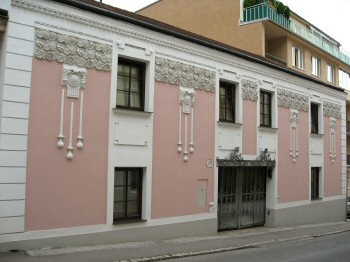
For example, Einsiedeleigasse no longer leads to the once so remote castle built in 1748 by a wealthy official of the Bohemian Court Chancellery together with the equerry of the Prince of Hildburghausen, who also only wanted to have "his holy rest". Today, on the slope of the Gemeindeberg, a "multiple settlement" is opening up, with new, beautifully situated residential buildings of the Vienna municipality, equipped with magnificent green spaces.
At Einsiedeleigasse No. 10, an Art Nouveau house was freshly renovated in 2008. For some time now, the house has housed a pharmacy.
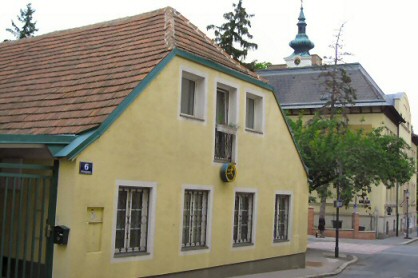
In Vitusgasse, house no. 6, an old farmhouse, still gives an idea of what the famous Ober-St. Veiter dairies once looked like.
In the 19th century, dairy farming prevailed over unsuccessful viticulture (more than 150 cows, 2 large dairy farms: Glasauer and Wimpissinger families).
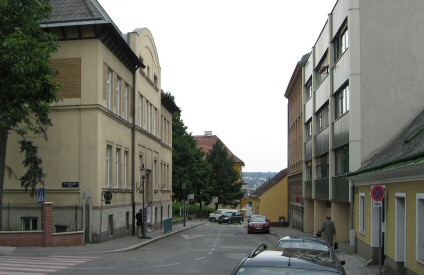
Vitusgasse Juli 2008
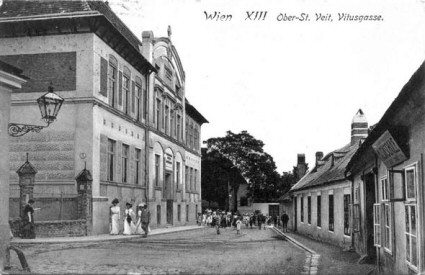
Vitusgasse 1910
In 1966, Erzbischofgasse, Vitusgasse and Adolfstorgasse represented the "New Upper St. Vitus". But if we wander through the alleys of the old former village, which had its most beautiful blossom under the aforementioned Prince-Bishop Leopold Maximilian Count of Firmian in the Biedermeier era, we still discover a lot of romance and some surprises. In front of the palace and the church we still find the park that this head bishop had laid out, and in Hietzinger Hauptstraße parts of the avenue planted by him.
Glasauergasse Juli 2008

Glasauergasse 1911
Glasauergasse branches off from the square in front of the church, named after Vienna's first prince-bishop Anton Wolfrath. It keeps alive the memory of the former mayor Glasauer, to whom Firmian's village owed much.

Houses No. 7 and No. 9 are still genuine winegrowers' houses in the Franconian courtyard style. Later they were also dairy farms, as can still be seen today in the windows of the former stables, which have long since become garages. A carpentry workshop is now housed in the stately, beautifully renovated wide courtyard at No. 24.
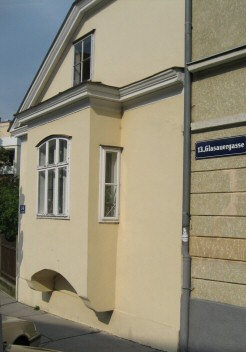
House No. 34 even still shows a late Gothic style (built on corbels) bay window with the typical "spy windows". Here, too, loving hands were at work.
The alley leading to the beautiful Streckerpark is named after Schubert's former publisher and still the terror of children learning the piano, Anton Diabelli. Under mighty trees, pensioners' benches and tables for chess and tarot. And an equally mighty memorial stone. In 1908, Mayor Lueger had Streckerpark, named after a commendable local councillor, laid out on the site of the old Ober St. Veiter cemetery. The atmospheric park is the centre of a "street star", of which Sommerergasse is particularly appealing.
For after the stately house of the old St. Vitus pharmacy, it suddenly becomes the Gasserl. And then it becomes a very narrow, secluded path between high walls and age-grey "planks", over which the green of quiet, midsummer gardens grows with all its might. Now and then only a lonely gas lantern. Thank God, they haven't all been scrapped, our much-praised Viennese gas lanterns. It's just that they have been fitted with electric light bulbs - in keeping with their original style.
The path continues with many a bend, and a long house wall appears, above which is a rather aged roof with chimneys, like those that once adorned the New Year's cards of the Viennese chimney sweepers.
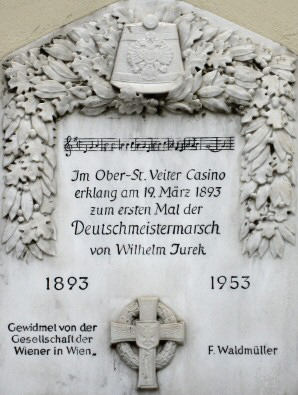
Then suddenly you are surprised to find yourself in front of the former "Ober-Sankt Veiter Kasino" almost at the end of Hietzinger Hauptstrasse. Now it houses a drugstore. And reads on a commemorative plaque, "On 19 March 1893, the Deutschmeister March by August Wilhelm Jurek sounded here for the first time". Above the inscription, beautifully carved in stone, an old Deutschmeister chako, wreathed in oak leaves, and below it the sign of the "Society of the Viennese in Vienna", which donated this plaque in 1953. The world-famous marching trio "Wir san vom k. u. k.. Infantry Regiment..." was heard for the first time in the village of Prince Bishop Firmian. Here, where up at the "Himmelhof" the Viennese forest reaches out to the big city.
The houses at Hietzinger Hauptstraße No. 154 and No. 123a described by Otto Stradal have had to make way for modern buildings. Even of the beautiful old avenue, which reveals the stately driveway behind an old-fashioned lattice fence - only two chestnut trees remain. The eastern boundary of old Ober-St. Veit in Rohrbacherstrasse also no longer has any old gardens and especially no unspoilt meadowland. Therefore, the evening barbecue concert hardly takes place any more.
The name of the small inn "Zum lustigen Radfahrer" in Rohrbacherstraße 21 is a miniature from the history of the sporting social clubs of bygone times. And in the courtyard of house 23 with its real pavlatches, time seems to stand still at all. But another memorial plaque reminded us that many important events in Austria's intellectual history took place in this "village" on the outskirts of Vienna. The Austrian African explorer Friedrich Julius Bieber lived in the house at Auhofstraße 144 from 1901 until his death in 1924 and wrote his most important works.
Then in the evening we turned to Firmiangasse itself, which rises from Auhofstrasse. At No. 11, in a real old Ober-St.-Veiter Heurigengartenhof: "A clean table, a smooth bench, not planed and polished". And above it the vine leaves entwine, on this summer evening the moon stands and the measured strike of the hour sounds from the tower of the Ober-St. Veiter church built by master Mathias Gerl in 1745. The neighbouring houses in this Firmiangasse are often still crouched and small and cosy. A little village on the edge of the big city, worth a contemplative holiday.
I' hab' halt a Faible für Ober Sankt Veit (Excerpt)
*) The author and publicist Otto Stradal was born on March 12, 1911, just as his family was moving to Hietzing.
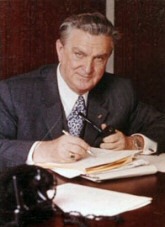
Professor Otto Stradal worked for the newspaper "Kurier" from 1950 until his death on December 7, 1982. In the columns "Mein Österreich" and "Bei uns am Grund" he wrote about art and culture in Austria. With his brother Ob. med. Rat Prim. Dr. Albert Stradal he owned an allotment garden in the allotment garden area Trazerberg, Trazerberggasse 8, where today there is a Stradalweg.